Assessment of Machine Learning Algorithms for Automatic Benthic Cover Monitoring and Mapping Using Towed Underwater Video Camera and High-Resolution Satellite Images
Abstract
1. Introduction
2. Materials and Methods
2.1. Study Area
2.2. Imagery Data
2.3. Benthic Cover Field Data
2.4. Methodology
- 1-
- An array of video recordings was converted to geo-located images using a free video to image converter program with 2 s intervals synchronized with the GNSS recorded locations.
- 2-
- Approximately 2000 converted images were labeled with four benthic cover categories algae, sediments, seagrass, and corals.
- 3-
- The labeled geo-located images were used as inputs to the BOF approach to create the attributes for automatic detection.
- 4-
- Three machine learning classifiers BAG, SVM, and K-NN were ensemble with WMV algorithm to detect the benthic cover category using the attributes produced from BOF as inputs and image labels as outputs.
- 5-
- Evaluation of the performance of classifiers was performed using independent 75% training and 25% testing samples.
- 6-
- Once the algorithms were validated and calibrated, they were used for categorizing more images, and the resultant images were checked individually.
- 7-
- About 1000 additional images were categorized automatically as correct, and checked individually for further analysis.
- 8-
- Approximately 3000 images correctly categorized with known locations over the field survey track were used for benthic cover mapping.
- 9-
- A Quickbird image was classified using the same ensemble classifiers with WMV approach, using about 3000 geo-located images with correctly categorized benthic habitats.
2.5. Proposed Algorithms for Benthic Cover Recognition and Mapping
2.5.1. Bag of Features
2.5.2. Bagging
2.5.3. Support Vector Machines
2.5.4. K-Nearest Neighbor (K-NN)
3. Results
4. Discussion
5. Conclusions
Author Contributions
Acknowledgments
Conflicts of Interest
References
- Tran, M. Mapping and Predicting Benthic Habitats in Estuaries Using Towed Underwater Video. Master’s Thesis, University of Technology, Sydney, Australia, 2013. [Google Scholar]
- Gauci, A.; Deidun, A.; Abela, J.; Zarb, K. Machine Learning for benthic sand and maerl classification and coverage estimation in coastal areas around the Maltese Islands. J. Appl. Res. Technol. 2016, 14, 338–344. [Google Scholar] [CrossRef]
- Lüdtke, A.; Jerosch, K.; Herzog, O.; Schlüter, M. Development of a machine learning technique for automatic analysis of seafloor image data: Case example, Pogonophora coverage at mud volcanoes. Comput. Geosci. 2012, 39, 120–128. [Google Scholar] [CrossRef]
- Guinan, J.; Brown, C.; Dolan, M.; Grehan, A. Ecological Informatics Ecological niche modelling of the distribution of cold-water coral habitat using underwater remote sensing data. Ecol. Inform. 2009, 4, 83–92. [Google Scholar] [CrossRef]
- Teixido, N.; Albajes-Eizagirre, A.; Bolbo, D.; Le Hir, E.; Demestre, M.; Garrabou, J.; Guigues, L.; Gili, J.M.; Piera, J.; Prelot, T.; Soria-Frisch, A. Hierarchical segmentation-based software for cover classification analyses of seabed images (Seascape). Mar. Ecol. Prog. Ser. 2011, 431, 45–53. [Google Scholar] [CrossRef]
- Bewley, M.; Friedman, A.; Ferrari, R.; Hill, N.; Hovey, R.; Barrett, N.; Pizarro, O.; Figueira, W.; Meyer, L.; Babcock, R.; et al. Australian sea-floor survey data, with images and expert annotations. Sci. Data 2015, 2, 150057. [Google Scholar] [CrossRef] [PubMed]
- Mallet, D.; Pelletier, D. Archimer Underwater video techniques for observing coastal marine biodiversity : A review of sixty years of publications (1952–2012). Fish. Res. 2014, 154, 44–62. [Google Scholar] [CrossRef]
- Seiler, J.; Friedman, A.; Steinberg, D.; Barrett, N.; Williams, A.; Holbrook, N. Image-based continental shelf habitat mapping using novel automated data extraction techniques. Cont. Shelf Res. 2012, 45, 87–97. [Google Scholar] [CrossRef]
- Rigby, P.; Pizarro, O.; Williams, S. Toward Adaptive Benthic Habitat Mapping Using Gaussian Process Classification. J. Field Robot. 2010, 27, 741–758. [Google Scholar] [CrossRef]
- Pizarro, O.; Rigby, P.; Johnson-Roberson, M.; Williams, S.B.; Colquhoun, J. Towards image-based marine habitat classification. In Proceedings of the MTS/ IEEE Oceans Conference, Quebec City, QC, Canada, 15–18 September 2008; pp. 1–7. [Google Scholar]
- Kutser, T.; Miller, I.; Jupp, D. Mapping coral reef benthic habitat with a hyperspectral spaceborne sensor. In Proceedings of the Ocean Optics XVI Conference, Santa Fe, NM, USA, 18–22 November 2002. [Google Scholar]
- Mobley, C.; Sundman, L.; Davis, C.; Bowles, J.; Downes, T.; Leathers, R.; Montes, M.; Bissett, W.; Kohler, D.; Reid, R.; et al. Interpretation of hyperspectral remote-sensing imagery by spectrum matching and look-up tables. Appl. Opt. 2005, 44, 3576–3592. [Google Scholar] [CrossRef] [PubMed]
- Giardino, C.; Candiani, G.; Bresciani, M.; Lee, Z.; Gagliano, S.; Pepe, M. BOMBER: A tool for estimating water quality and bottom properties from remote sensing images. Comput. Geosci. 2012, 45, 313–318. [Google Scholar] [CrossRef]
- Zhang, C. Applying data fusion techniques for benthic habitat mapping and monitoring in a coral reef ecosystem. ISPRS J. Photogramm. Remote Sens. 2015, 104, 213–223. [Google Scholar] [CrossRef]
- Hasan, R.; Ierodiaconou, D.; Laurenson, L. Combining angular response classification and backscatter imagery segmentation for benthic biological habitat mapping. Estuar. Coast. Shelf Sci. 2012, 97, 1–9. [Google Scholar] [CrossRef]
- Hasan, R.; Ierodiaconou, D.; Laurenson, L.; Schimel, A. Integrating multibeam backscatter angular response, mosaic and bathymetry data for benthic habitat mapping. PLoS ONE 2014, 9, e97339. [Google Scholar]
- Reshitnyk, L.; Costa, M.; Robinson, C.; Dearden, P. Evaluation of WorldView-2 and acoustic remote sensing for mapping benthic habitats in temperate coastal Pacific waters. Remote Sens. Environ. 2014, 153, 7–23. [Google Scholar] [CrossRef]
- Diesing, M.; Stephens, D. A multi-model ensemble approach to seabed mapping. J. Sea Res. 2015, 100, 62–69. [Google Scholar] [CrossRef]
- Phinn, S.; Roelfsema, C.; Mumby, P. Multi-scale, object-based image analysis for mapping geomorphic and ecological zones on coral reefs. Int. J. Remote Sens. 2012, 33, 3768–3797. [Google Scholar] [CrossRef]
- Zapata-Ramírez, P.; Blanchon, P.; Olioso, A.; Hernandez-Nuñez, H.; Sobrino, J. Accuracy of IKONOS for mapping benthic coral-reef habitats: A case study from the Puerto Morelos Reef National Park, Mexico. Int. J. Remote Sens. 2013, 34, 3671–3687. [Google Scholar] [CrossRef]
- Collin, A.; Nadaoka, K.; Nakamura, T. Mapping VHR Water Depth, Seabed and Land Cover Using Google Earth Data. ISPRS Int. J. Geo-Inf. 2014, 3, 1157–1179. [Google Scholar] [CrossRef]
- Eugenio, F.; Marcello, J.; Martin, J. High-Resolution Maps of Bathymetry and Benthic Habitats in Shallow-Water Environments Using Multispectral Remote Sensing Imagery. IEEE Trans. Geosci. Remote Sens. 2015, 53, 3539–3549. [Google Scholar] [CrossRef]
- Hedley, J.; Roelfsema, C.; Chollett, I.; Harborne, A.; Heron, S.; Weeks, S.; Skirving, W.; Strong, A.; Eakin, C.M.; Christensen, T.; et al. Remote sensing of coral reefs for monitoring and management: A review. Remote Sens. 2016, 8, 1–40. [Google Scholar] [CrossRef]
- Estomata, M.; Blanco, A.; Nadaoka, K.; Tomoling, E. Extraction of Benthic Cover Information from Video Tows and Photographs Using Object-Based Image Analysis. In Proceedings of the International Archives of the Photogrammetry, Remote Sensing and Spatial Information Science, XXXIX-B8, XXII ISPRS Congress, Melbourne, QC, Australia, 25 August–1 September 2012; pp. 539–544. [Google Scholar]
- Roelfsema, C.; Phinn, S.; Udy, N.; Maxwell, P. An integrated field and remote sensing approach for mapping Seagrass Cover, Moreton Bay, Australia. J. Spat. Sci. 2009, 54, 45–62. [Google Scholar] [CrossRef]
- Liu, Z.G.; Zhang, X.Y.; Yang, Y.; Wu, C.C. A Flame Detection Algorithm Based on Bag-of—Features In The YUV Color Space. In Proceedings of the International Conference on Intelligent Computing and Internet of Things (IC1T), Harbin, China, 10–12 December 2015; pp. 64–67. [Google Scholar]
- Yu, J.; Qin, Z.; Wan, T.; Zhang, X. Feature integration analysis of bag-of-features model for image retrieval. Neurocomputing 2013, 120, 355–364. [Google Scholar] [CrossRef]
- Yang, S.; Bebis, G.; Chu, Y.; Zhao, L. Effective face recognition using bag of features with additive kernels. J. Electron. Imaging 2016, 25. [Google Scholar] [CrossRef]
- Breiman, L. Bagging Predictors. Mach. Learn. 1996, 24, 123–140. [Google Scholar] [CrossRef]
- Kulkarni, S.; Kelkar, V. Classification of Multispectral Satellite Images Using Ensemble Techniques of Bagging, Boosting and Ada-Boost. In Proceedings of the International Conference on Circuits, Systems, Communication and Information Technology Applications (CSCITA) Classification, Mumbai, India, 4–5 April 2014; pp. 253–258. [Google Scholar]
- Ghimire, B.; Rogan, J.; Rodriguez-Galiano, V.; Panday, P.; Neeti, N. An Evaluation of Bagging, Boosting, and Random Forests for Land-Cover Classiication in Cape Cod, Massachusetts, USA. GISci. Remote Sens. 2012, 5, 623–643. [Google Scholar] [CrossRef]
- DeFries, R.; Chan, J. Multiple Criteria for Evaluating Machine Learning Algorithms for Land Cover Classification from Satellite Data. Remote Sens. Environ. 2000, 74, 503–515. [Google Scholar] [CrossRef]
- Cortes, C.; Vapnik, V. Support-Vector Networks. Mach. Learn. 1995, 20, 273–297. [Google Scholar] [CrossRef]
- Chu, H.; Ge, L. Combination of Genetic Algorithm and Dempster-Shafer Theory of Evidence for Land Cover Classification Using Integration of Sar and Optical Satellite Imagery. In Proceedings of the International Archives of the Photogrammetry, Remote Sensing and Spatial Information Sciences, Volume XXXIX-B7, XXXIX Congres, Melbourne, QC, Australia, 25 August–1 September 2012; pp. 173–178. [Google Scholar]
- Kavzoglu, T.; Colkesen, I. A kernel functions analysis for support vector machines for land cover classification. Int. J. Appl. Earth Obs. Geoinf. 2009, 11, 352–359. [Google Scholar] [CrossRef]
- Lenz, B.; Barak, B. Data Mining and Support Vector Regression Machine Learning in Semiconductor Manufacturing to improve virtual metrology. In Proceedings of the Annual Hawaii International Conference on System Sciences, Wailea, HI, USA, 7–10 January 2013; pp. 3447–3456. [Google Scholar]
- Tzeng, Y.; Fan, K.; Chen, K. An adaptive thresholding multiple classifiers system for remote sensing image classification. Eng. Remote Sens. 2009, 75, 679–687. [Google Scholar] [CrossRef]
- He, J.; Tan, A.; Tan, C. On Machine Learning Methods for Chinese Document Categorization. Appl. Intell. 2003, 18, 311–322. [Google Scholar] [CrossRef]
- Wan, C.; Lee, L.; Rajkumar, R.; Isa, D. A hybrid text classification approach with low dependency on parameter by integrating K-nearest neighbor and support vector machine. Expert Syst. Appl. 2012, 39, 11880–11888. [Google Scholar] [CrossRef]
- Gutierrez-Osuna, R. Lecture Notes CS 790: Introduction to Pattern Recognition; Dayton, OH, USA. 2002. Available online: http://research.cs.tamu.edu/prism/lectures/iss/iss_l1.pdf (accessed on 20 June 2017).
- Liu, H.; Zhang, S. Noisy data elimination using mutual k-nearest neighbor for classification mining. J. Syst. Softw. 2012, 85, 1067–1074. [Google Scholar] [CrossRef]
- Shihavuddin, A.; Gracias, N.; Garcia, R.; Gleason, A.; Gintert, B. Image-based coral reef classification and thematic mapping. Remote Sens. 2013, 5, 1809–1841. [Google Scholar] [CrossRef]
- Muslim, A.; Komatsu, T.; Dianachia, D. Evaluation of classification techniques for benthic habitat mapping. Proc. SPIE 2012, 8525, 85250W. [Google Scholar]
- Pu, R.; Bell, S. Mapping seagrass coverage and spatial patterns with high spatial resolution IKONOS imagery. Int. J. Appl. Earth Obs. Geoinf. 2017, 54, 145–158. [Google Scholar] [CrossRef]
- Roelfsema, C.; Lyons, M.; Dunbabin, M.; Kovacs, E.; Phinn, S. Integrating field survey data with satellite image data to improve shallow water seagrass maps: The role of AUV and snorkeller surveys. Remote Sens. Lett. 2015, 6, 135–144. [Google Scholar] [CrossRef]
- Kutser, T.; Vahtmäe, E.; Roelfsema, C.; Metsamaa, L. Photo-library method for mapping seagrass biomass. Estuar. Coast. Shelf Sci. 2007, 75, 559–563. [Google Scholar] [CrossRef]
- Baumstark, R.; Dixon, B.; Carlson, P.; Palandro, D.; Kolasa, K. Alternative spatially enhanced integrative techniques for mapping seagrass in Florida’s marine ecosystem. Int. J. Remote Sens. 2013, 34, 1248–1264. [Google Scholar] [CrossRef]
- Baumstark, R.; Duffey, R.; Pu, R. Mapping seagrass and colonized hard bottom in Springs Coast, Florida using WorldView-2 satellite imagery. Estuar. Coast. Shelf Sci. 2016, 170, 45–60. [Google Scholar] [CrossRef]
- Vassallo, P.; Bianchi, C.; Paoli, C.; Holon, F.; Augusto, N.; Bavestrello, G.; Vietti, R.; Morri, C. A predictive approach to benthic marine habitat mapping: Efficacy and management implications. Mar. Pollut. Bull. 2018, 131, 218–232. [Google Scholar] [CrossRef]
- Collin, A.; Archambault, P.; Long, B. Predicting species diversity of benthic communities within turbid nearshore using full-waveform bathymetric LiDAR and machine learners. PLoS ONE 2011, 6, e21265. [Google Scholar] [CrossRef] [PubMed]
- Wahidin, N.; Siregar, V.; Nababan, B.; Jaya, I.; Wouthuyzen, S. Object-based Image Analysis for Coral Reef Benthic Habitat Mapping with Several Classification Algorithms. Procedia Environ. Sci. 2015, 24, 222–227. [Google Scholar] [CrossRef]
- González-Rivero, M.; Beijbom, O.; Rodriguez-Ramirez, A.; Holtrop, T.; González-Marrero, Y.; Ganase, A.; Roelfsema, C.; Phinn, S.; Hoegh-Guldberg, O. Scaling up ecological measurements of coral reefs using semi-automated field image collection and analysis. Remote Sens. 2016, 8, 30. [Google Scholar] [CrossRef]
- Pante, E.; Dustan, P. Getting to the point: Accuracy of point count in monitoring ecosystem change. J. Mar. Biol. 2012. [Google Scholar] [CrossRef]
- Roelfsema, C.; Kovacs, E.; Ortiz, J.; Wolff, N.; Callaghan, D.; Wettle, M.; Ronan, M.; Hamylton, S.; Mumby, P.; Phinn, S. Coral reef habitat mapping: A combination of object-based image analysis and ecological modelling. Remote Sens. Environ. 2018, 208, 27–41. [Google Scholar] [CrossRef]
- Roelfsema, C.; Phinn, S. Integrating field data with high spatial resolution multispectral satellite imagery for calibration and validation of coral reef benthic community maps. J. Appl. Remote Sens. 2010, 4. [Google Scholar] [CrossRef]
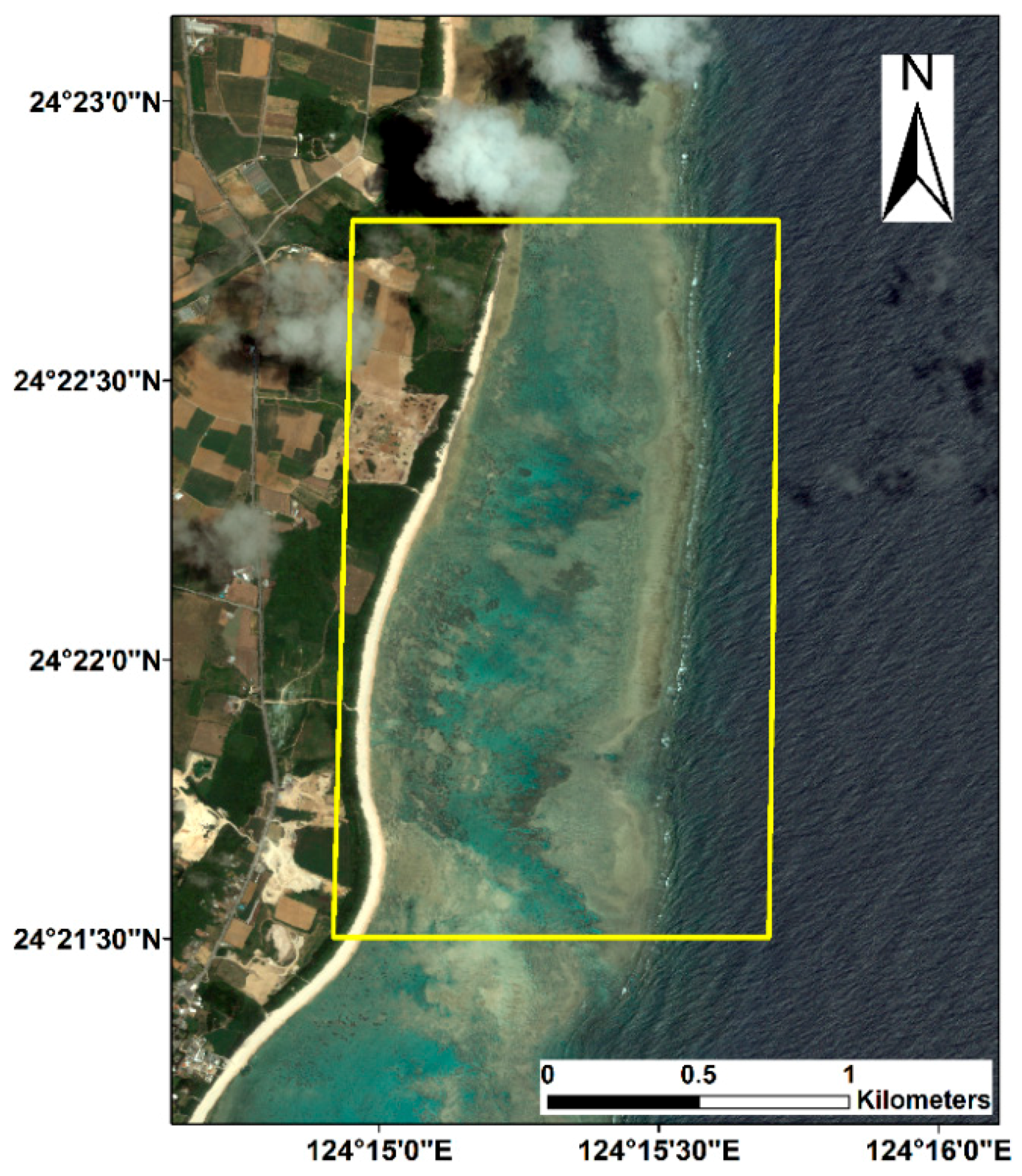
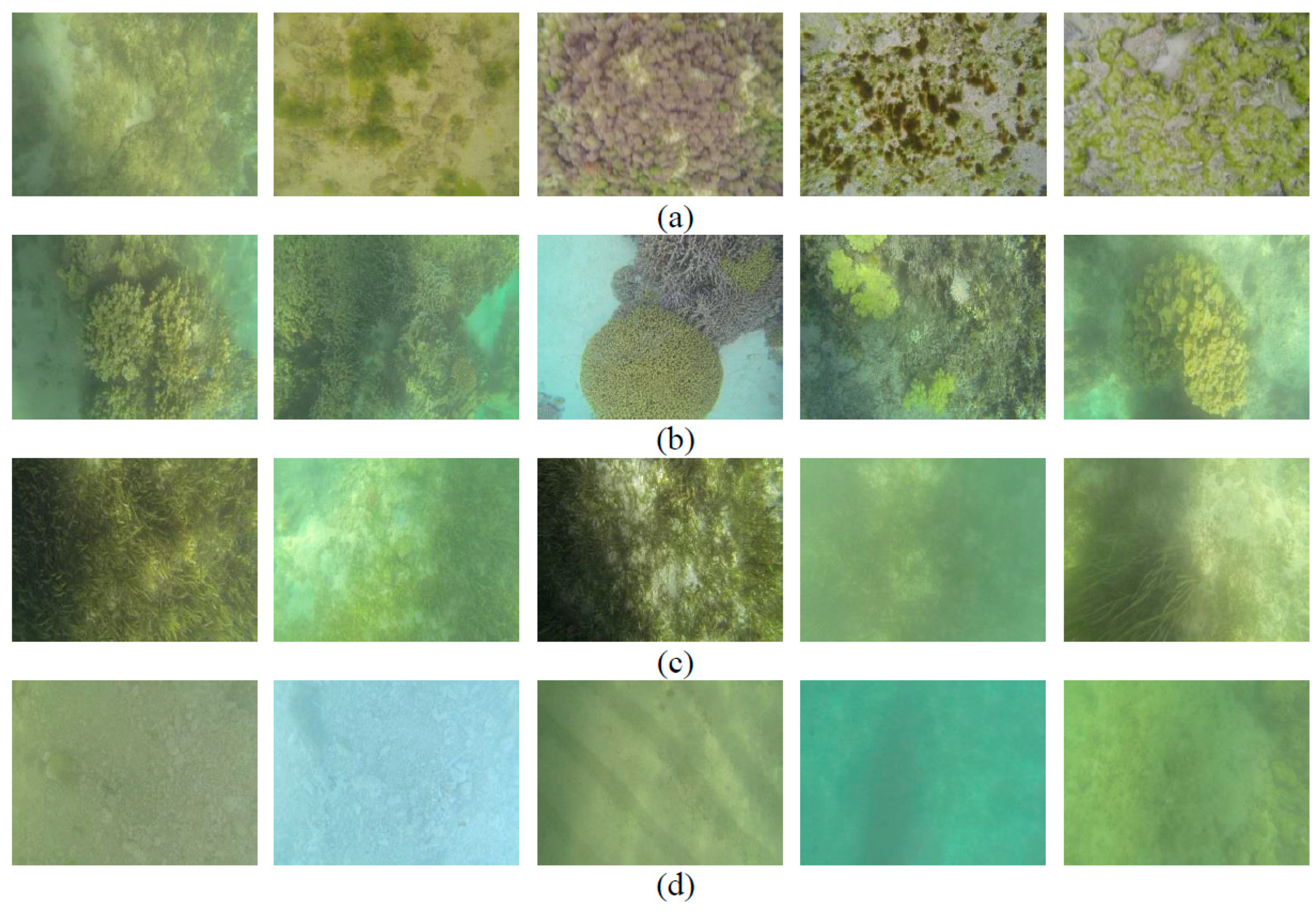
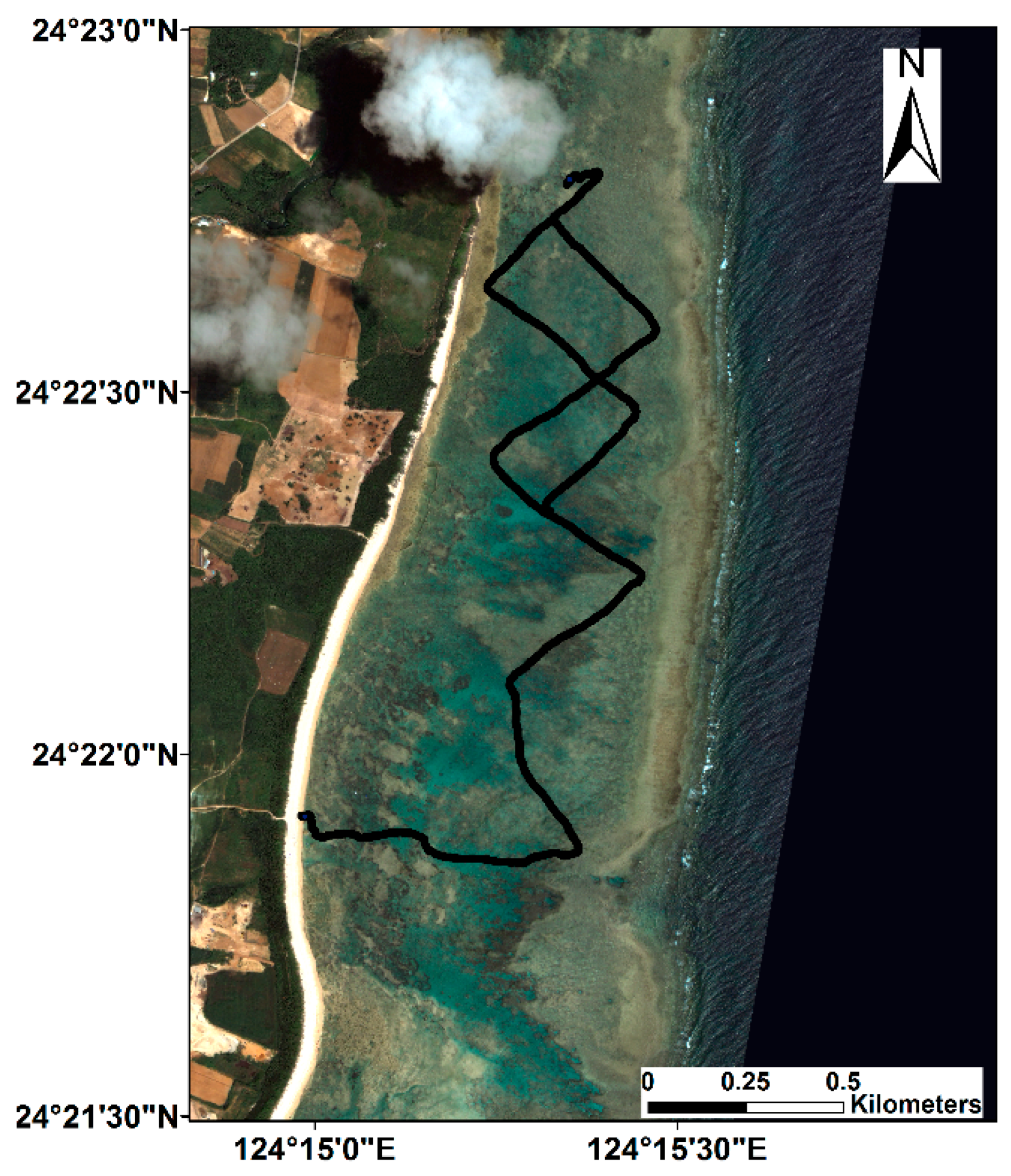
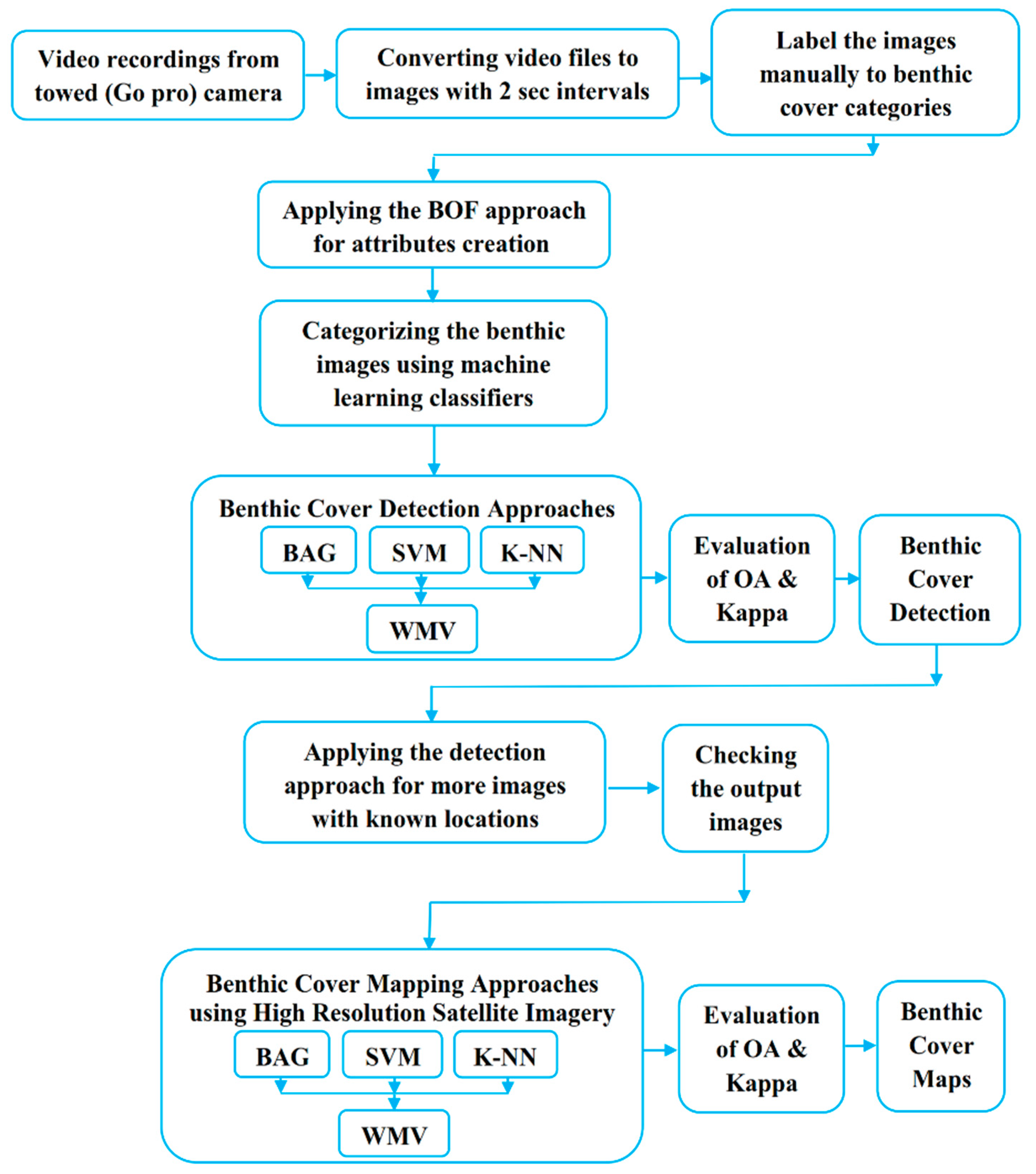
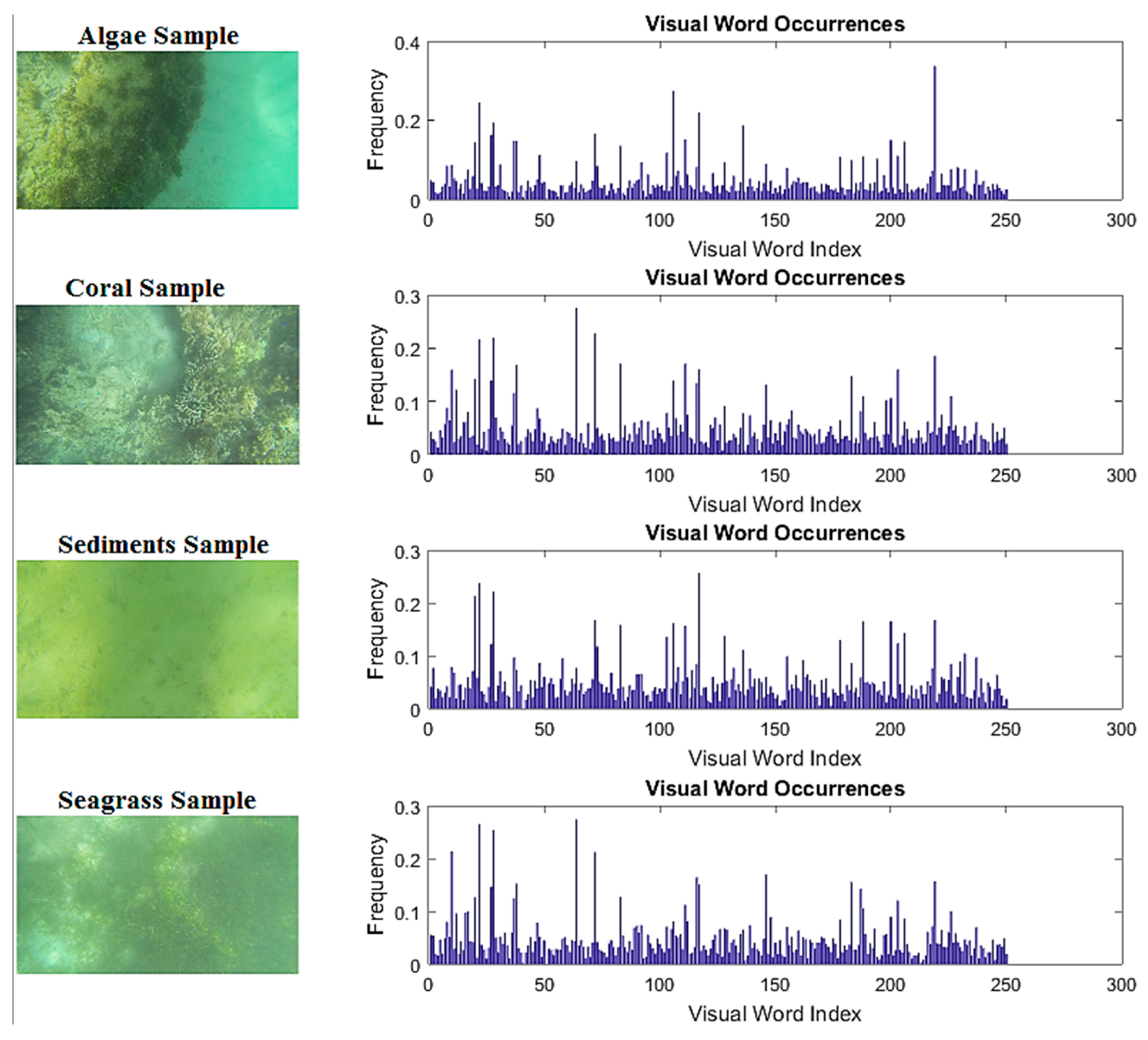
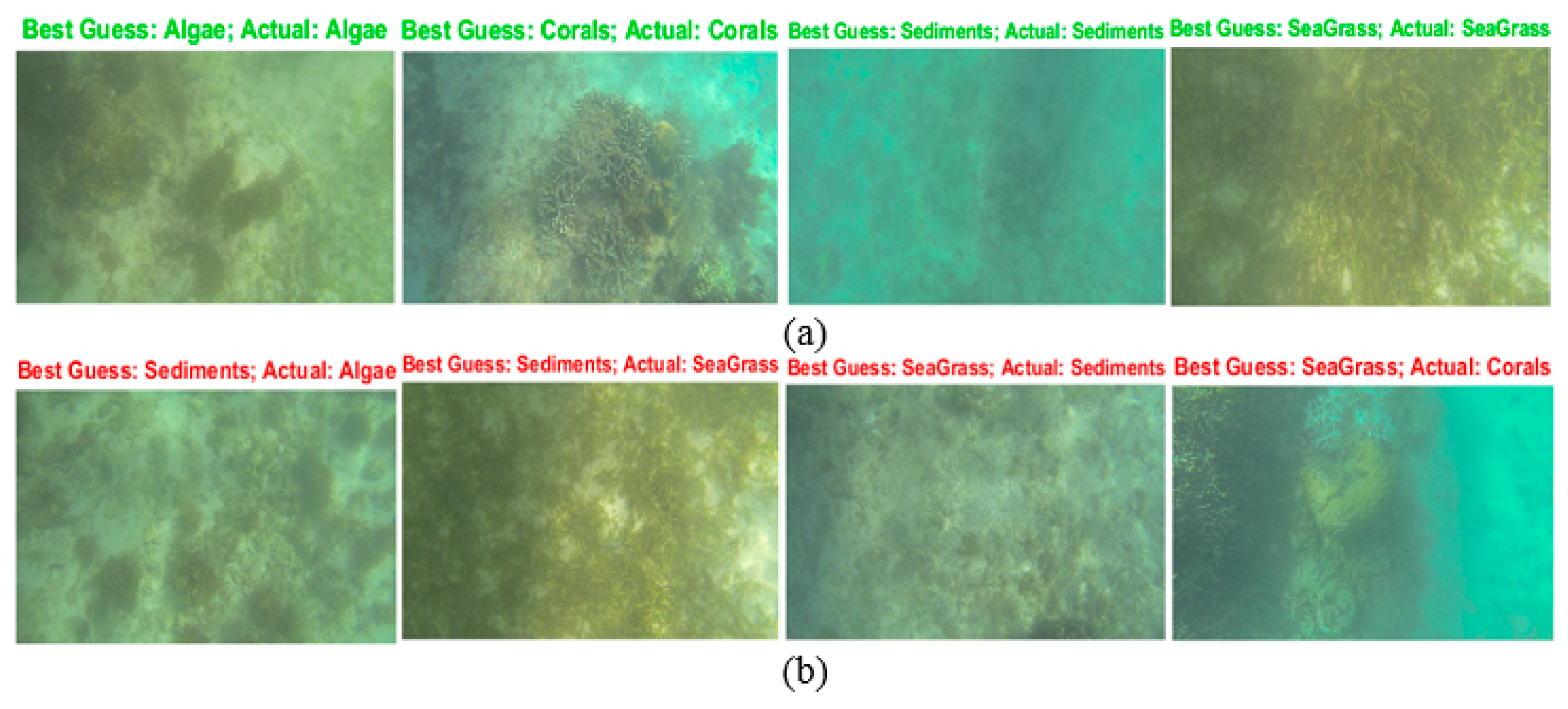
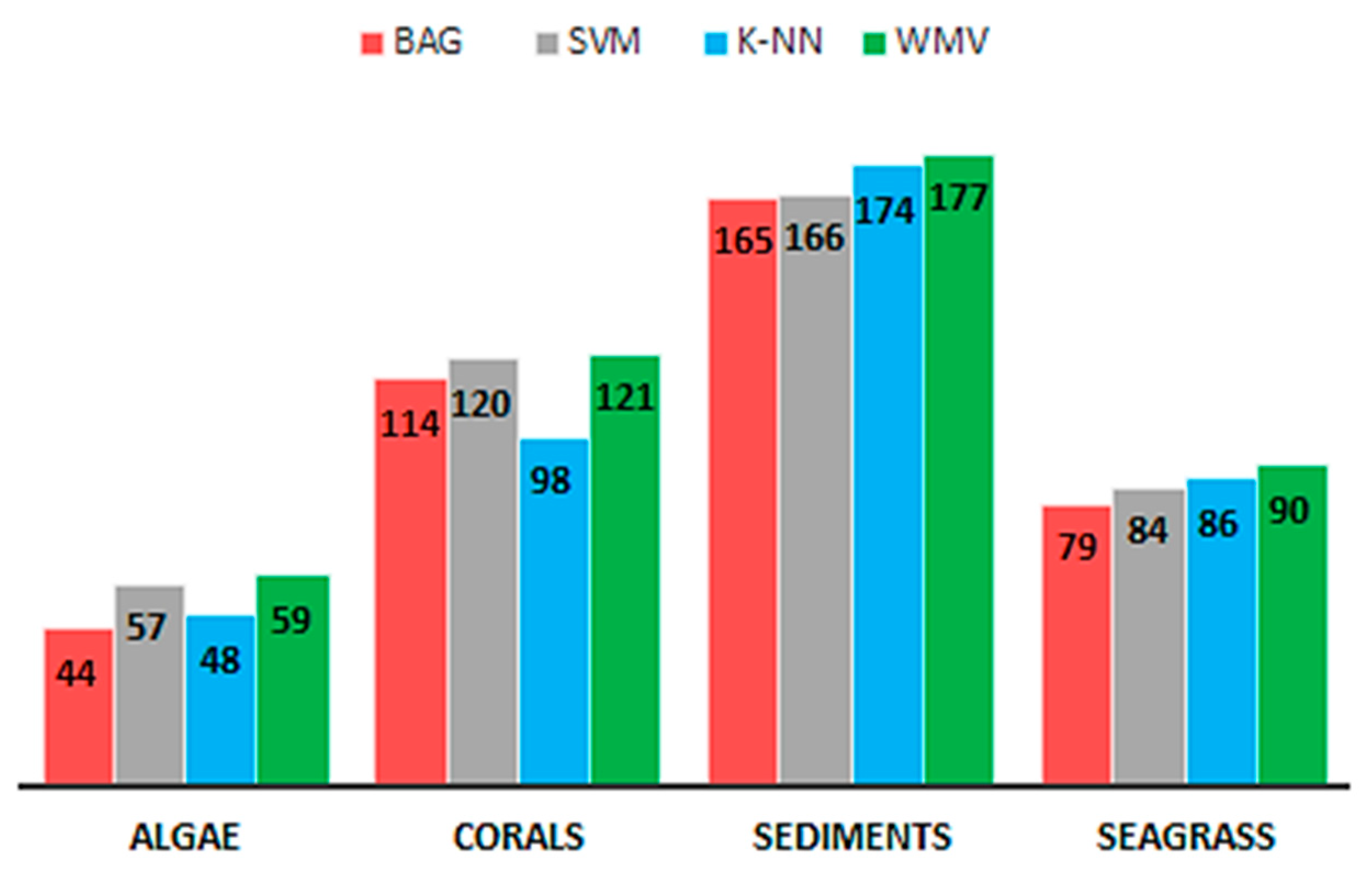
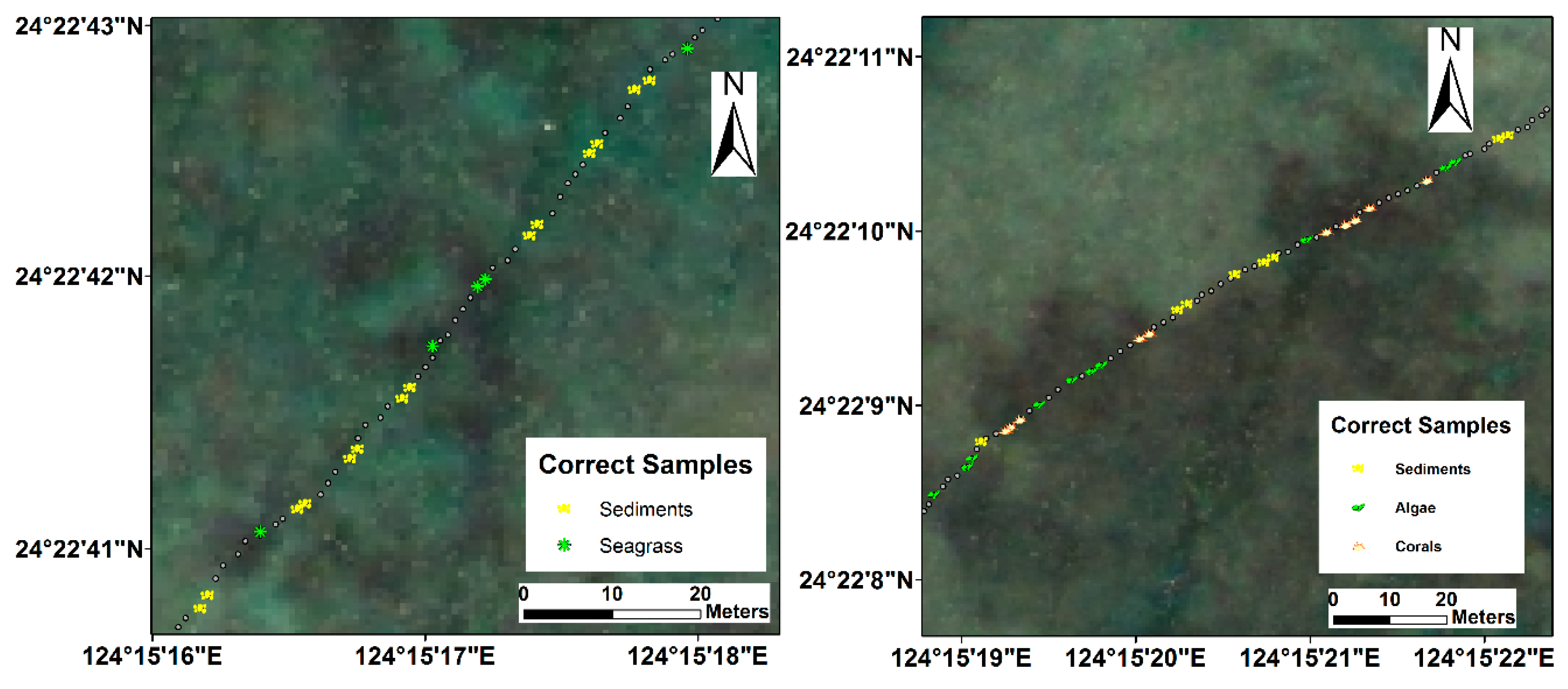
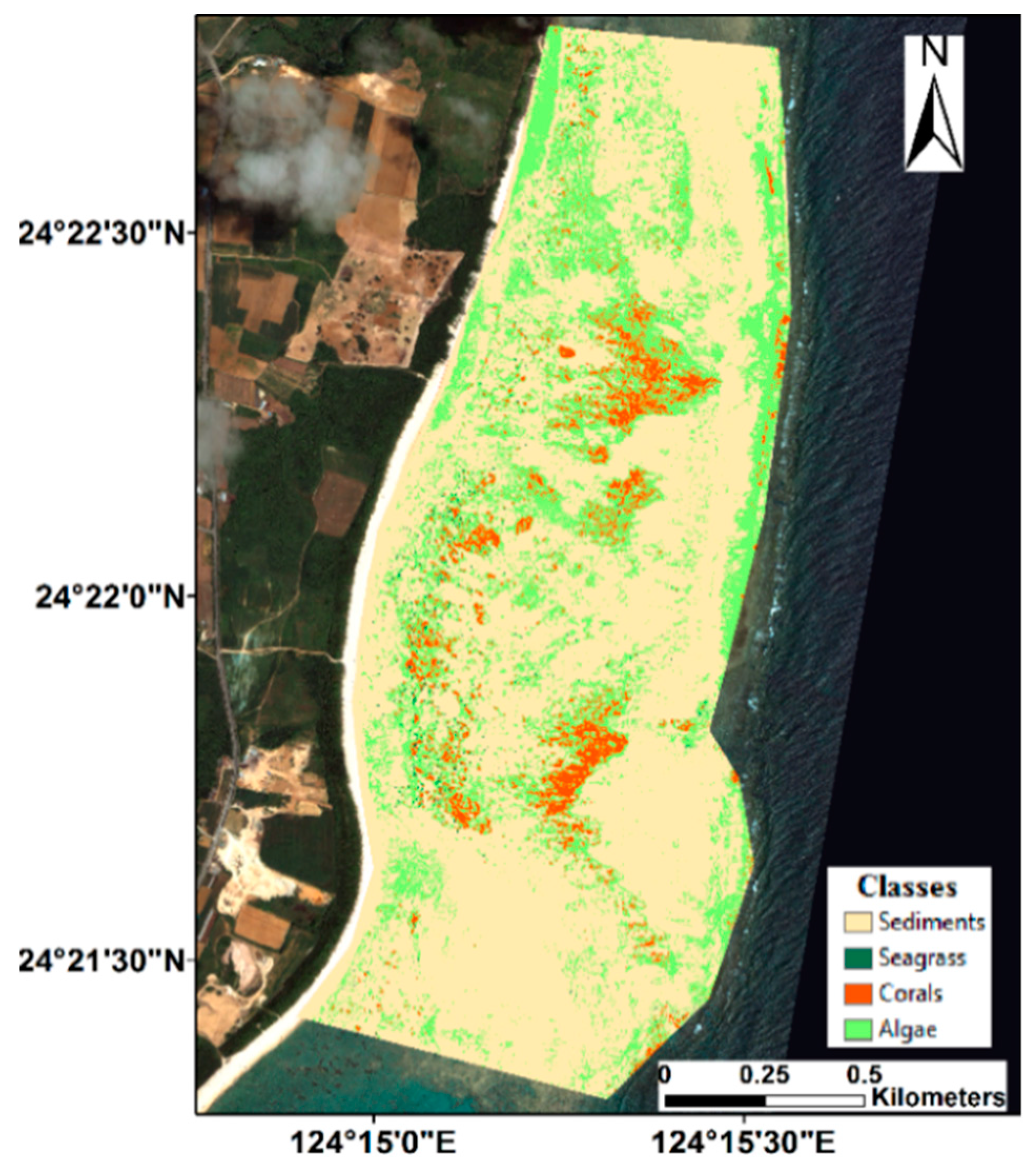
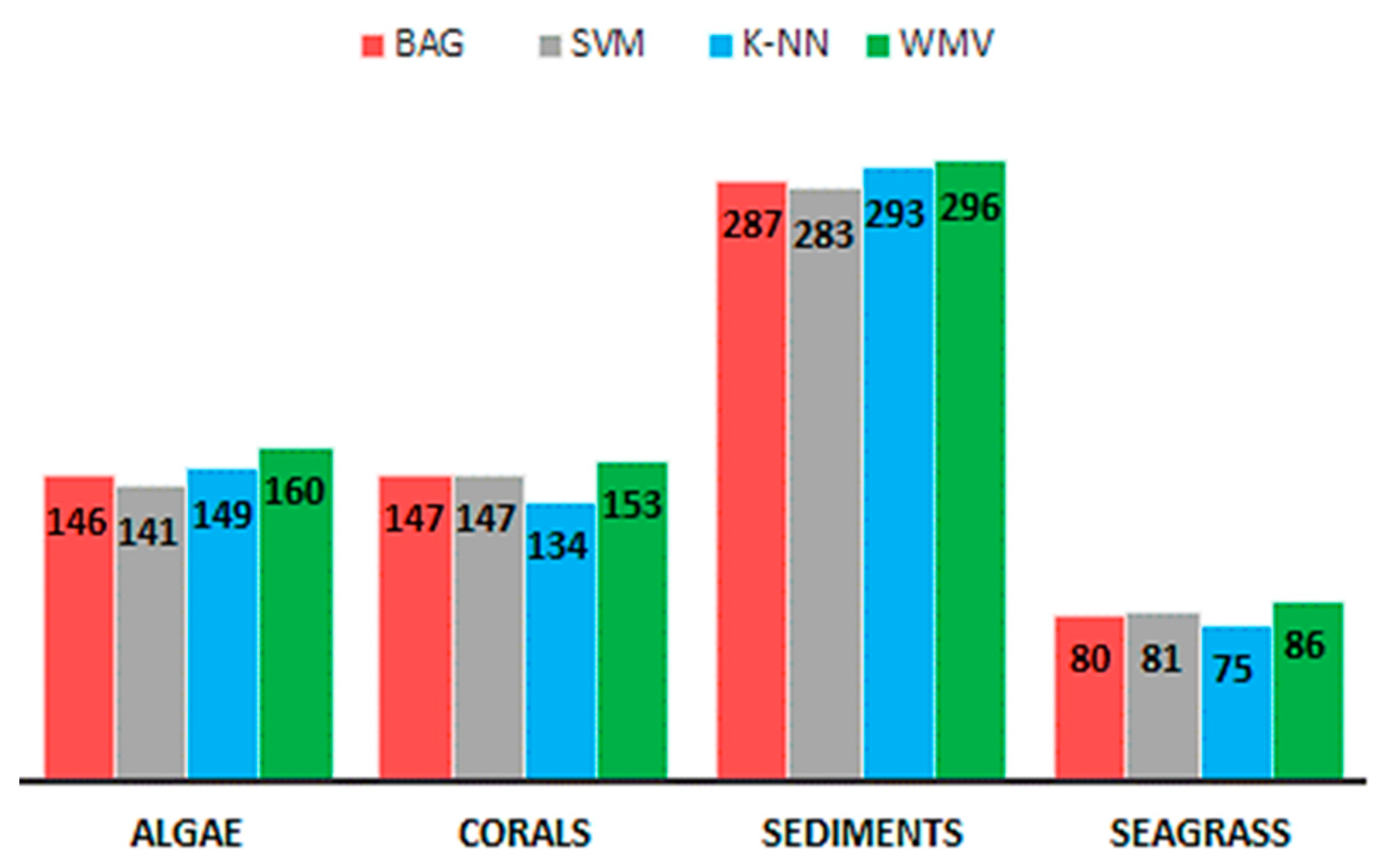
| Methodology | BAG | K-NN | SVM | WMV |
|---|---|---|---|---|
| OA % | 80.4 | 81.4 | 85.6 | 89.4 |
| Kappa | 0.73 | 0.74 | 0.80 | 0.85 |
| Classification Data | Reference Data | Row. Total | UA | |||
|---|---|---|---|---|---|---|
| Algae | Corals | Sediments | Seagrass | |||
| Algae | 59 | 11 | 3 | 4 | 77 | 77% |
| Corals | 2 | 121 | 3 | 5 | 131 | 92% |
| Sediments | 17 | 6 | 177 | 1 | 201 | 88% |
| Seagrass | 0 | 1 | 0 | 90 | 91 | 99% |
| Col. Total | 78 | 139 | 183 | 100 | OA = 89.4% | |
| PA | 76% | 87% | 97% | 90% | Kappa val. = 0.85 | |
| Methodology | BAG | K-NN | SVM | WMV |
|---|---|---|---|---|
| OA % | 88.0 | 86.8 | 86.9 | 92.7 |
| Kappa | 0.83 | 0.81 | 0.81 | 0.89 |
| Classification Data | Reference Data | Row. Total | UA | |||
|---|---|---|---|---|---|---|
| Algae | Corals | Sediments | Seagrass | |||
| Algae | 160 | 9 | 4 | 5 | 178 | 90% |
| Corals | 9 | 153 | 0 | 6 | 168 | 91% |
| Sediments | 3 | 7 | 296 | 3 | 309 | 96% |
| Seagrass | 3 | 6 | 0 | 86 | 95 | 91% |
| Col. Total | 175 | 175 | 300 | 100 | OA = 92.7% | |
| PA | 91% | 87% | 98% | 86% | Kappa val. = 0.89 | |
© 2018 by the authors. Licensee MDPI, Basel, Switzerland. This article is an open access article distributed under the terms and conditions of the Creative Commons Attribution (CC BY) license (http://creativecommons.org/licenses/by/4.0/).
Share and Cite
Mohamed, H.; Nadaoka, K.; Nakamura, T. Assessment of Machine Learning Algorithms for Automatic Benthic Cover Monitoring and Mapping Using Towed Underwater Video Camera and High-Resolution Satellite Images. Remote Sens. 2018, 10, 773. https://doi.org/10.3390/rs10050773
Mohamed H, Nadaoka K, Nakamura T. Assessment of Machine Learning Algorithms for Automatic Benthic Cover Monitoring and Mapping Using Towed Underwater Video Camera and High-Resolution Satellite Images. Remote Sensing. 2018; 10(5):773. https://doi.org/10.3390/rs10050773
Chicago/Turabian StyleMohamed, Hassan, Kazuo Nadaoka, and Takashi Nakamura. 2018. "Assessment of Machine Learning Algorithms for Automatic Benthic Cover Monitoring and Mapping Using Towed Underwater Video Camera and High-Resolution Satellite Images" Remote Sensing 10, no. 5: 773. https://doi.org/10.3390/rs10050773
APA StyleMohamed, H., Nadaoka, K., & Nakamura, T. (2018). Assessment of Machine Learning Algorithms for Automatic Benthic Cover Monitoring and Mapping Using Towed Underwater Video Camera and High-Resolution Satellite Images. Remote Sensing, 10(5), 773. https://doi.org/10.3390/rs10050773






